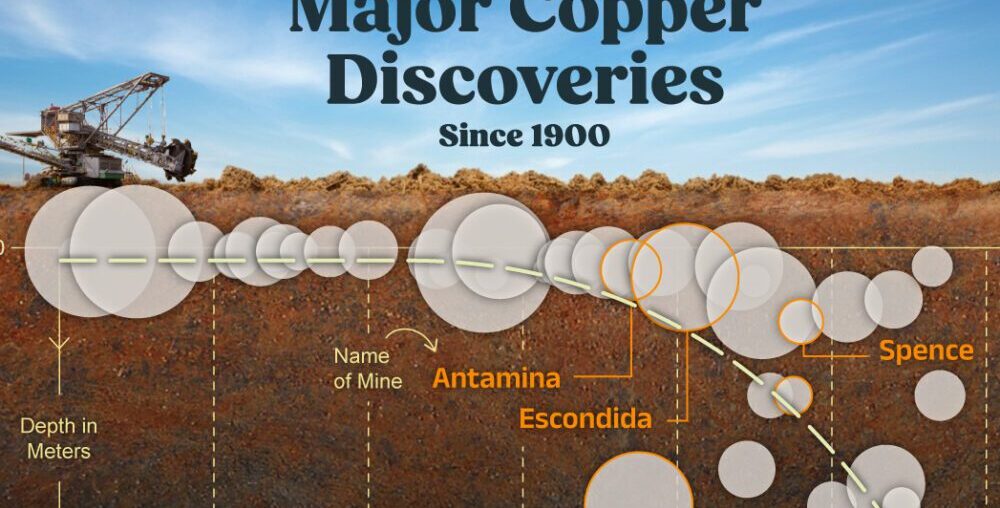Visualized: Major Copper Discoveries Since 1900
In the evolving landscape of copper mining, deposits are increasingly challenging to locate and extract.
As deposits are found deeper underground, accessing these resources becomes more costly and technically complex, ultimately impacting copper prices.
To highlight this trend, Visual Capitalist partnered with BHP to show the depths and sizes of major copper discoveries found since 1900.
A Century of Copper Discoveries
This graphic shows copper discoveries with over 3 million metric tons of copper equivalent, based on data from MinEx Consulting and BHP up to 2022.
The latest major discovery, made by Filo del Sol in 2020, lies 600 meters below ground and contains just over 11 million metric tons of copper equivalent.
| Deposit Name | Discovery Year | Million metric tons of copper equivalent | Depth (Meters) |
|---|---|---|---|
| Filo Del Sol | 2020 | 11 | -600 |
| Hu’u | 2015 | 15 | -550 |
| Kakula | 2014 | 19 | -200 |
| Cascabel | 2013 | 12 | -25 |
| Timok | 2012 | 16 | -460 |
| Los Helados | 2009 | 11 | -350 |
| Kamoa | 2008 | 25 | -70 |
| Los Sulfatos | 2007 | 45 | -320 |
| Heruga | 2005 | 7 | -950 |
| Carapateena | 2005 | 5 | -470 |
| Pebble | 2002 | 37 | -80 |
| Resolution | 2002 | 27 | -1280 |
| Hugo Dummett | 2002 | 19 | -500 |
| Centinela (Sulphide) | 2000 | 18 | -350 |
| Spence Cu Camp | 1996 | 15 | -100 |
| Escondida Norte | 1995 | 10 | -200 |
| Tampakan | 1992 | 15 | -200 |
| Collahuasi Cu Au Camp | 1991 | 92 | -75 |
| Batu Hijau | 1990 | 8 | -45 |
| Ministro Hales | 1989 | 24 | -300 |
| Grasberg-Ertsberg Project (Camp) | 1988 | 57 | -25 |
| Escondida (Main Deposit) | 1981 | 85 | -40 |
| Los Bronces | 1978 | 33 | -20 |
| Salobo | 1977 | 10 | -40 |
| Olympic Dam | 1975 | 86 | -350 |
| Antamina | 1974 | 27 | -30 |
| Los Pelambres | 1971 | 38 | -20 |
| Ok Tedi | 1969 | 9 | -20 |
| Sar Cheshmeh Cu Camp | 1967 | 30 | -20 |
| El Abra Cu Camp | 1965 | 18 | -20 |
| Panguna | 1965 | 9 | -20 |
| Kidd Creek | 1963 | 5 | -30 |
| Lubin Cu Camp | 1957 | 66 | -5 |
| Palabora | 1956 | 8 | -35 |
| Andina Cu Camp | 1955 | 144 | -20 |
| Chambishi | 1952 | 6 | -13 |
| Gaisky Complex | 1950 | 8 | -30 |
| Udokan | 1949 | 27 | -15 |
| Kamoto Cu/Co-Operation | 1940 | 26 | -3 |
| Konkola (Bancroft) | 1935 | 19 | -5 |
| Kalmakyr | 1931 | 10 | -5 |
| Dzhezkazgan | 1929 | 22 | -5 |
| Nkana (Rokana) Division | 1928 | 11 | -5 |
| Cananea Cu Camp | 1926 | 35 | -5 |
| Mufulira | 1923 | 16 | -10 |
| Nchanga | 1923 | 15 | -10 |
| Tenke Fungurume | 1918 | 27 | -5 |
| Chuquicamata Cu Camp | 1910 | 131 | -5 |
| El Teniente | 1904 | 127 | -5 |
| Ely/Robinson | 1902 | 6 | -5 |
Andina Copper Camp, discovered in 1955 in Chile, holds a massive 144 million metric tons of copper equivalent, making it the largest deposit discovered since 1900. However, deposits of this scale near the surface are becoming increasingly rare.
Notable discoveries like the Escondida deposit, found at a relatively shallow depth of only 40 meters in 1981, contrast sharply with newer, deeper finds like the Resolution deposit, discovered in 2002 at a depth of 1,280 meters.
The Future of Copper Mining
This trend in recent copper discoveries highlights that copper mines are harder to develop than ever before.
And while copper recycling is expected to play an essential role in meeting growing demand, it won’t be sufficient on its own, according to BHP. An emphasis on primary supply, along with technological progress that improves mine productivity, is crucial.
Overall, BHP’s analysis estimates that a $250 billion investment in the sector is necessary in the next decade to overcome these challenges.

